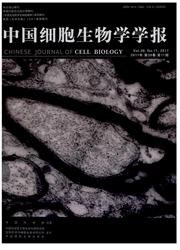

 中文摘要:
中文摘要:
支架和连接蛋白在调节信号级联传导中起着重要作用。最近,Ego1/Ego3蛋白复合物被证实作为定位在细胞内体膜表面的支架蛋白在TORCl信号通路感知氨基酸丰度方面发挥重要调控作用。研究中通过克隆酵母Ego1与Ego3基因,构建了双T7启动子的双元原核表达载体。通过在大肠杆菌中共表达、共破菌以及带有不同抗性的两个质粒共转化的方法来重组表达Ego1/Ego3复合物。结果发现,Ego1可与Ego3蛋白形成可溶性的复合物,但纯化后蛋白比例存在明显差异,且Ego1有降解现象。通过构建一系列带组氨酸标签截短的Ego1与全长Ego3共表达,依靠pulldown纯化来鉴定Ego1与Ego3相互作用的区段。最终发现,共转化pRSFDuet-mcs1 Ego1(35-184)和pACYDuet-mcsl Ego3共表达、纯化到较稳定的比例较一致的复合物,从而为进一步对Ego1/Ego3蛋白复合物进行生化鉴定和结构生物学研究奠定了基础。
 英文摘要:
英文摘要:
Scaffold and adaptor proteins play crucial roles in many key signaling cascades. Egol is a scaffold protein and together with Ego3 forms a subunit of EGO complex that is shown to be responsible for localization of TORC1 to the endosomal membrane surface. To biochemically and biophysically characterize the Ego1/ Ego3 complex, we constructed various binary expression vectors with Egol and Ego3 gene to co-express recombinant Egol and Ego3 protein. Co-expression of Ego1 and Ego3 in E.coli led to a soluble protein complex. By co- expression after co-transformation with different antibiotic-resistant duet plasmids into cells, the protein ratio prob- lem could be improved in the complex. Furthermore, we subcloned several truncated Ego 1 and full-length Ego 1 into binary vectors and characterized the binding between the truncated Ego1 and Ego3 by co-purification. Finally, we obtained a stable truncated Ego 1 (35-184) fragment in complex with Ego3 via co-transformation of pRSFDuet- Ego 1 (35-184) and pACYDuet-Ego3.
 同期刊论文项目
同期刊论文项目
 同项目期刊论文
同项目期刊论文
 期刊信息
期刊信息
